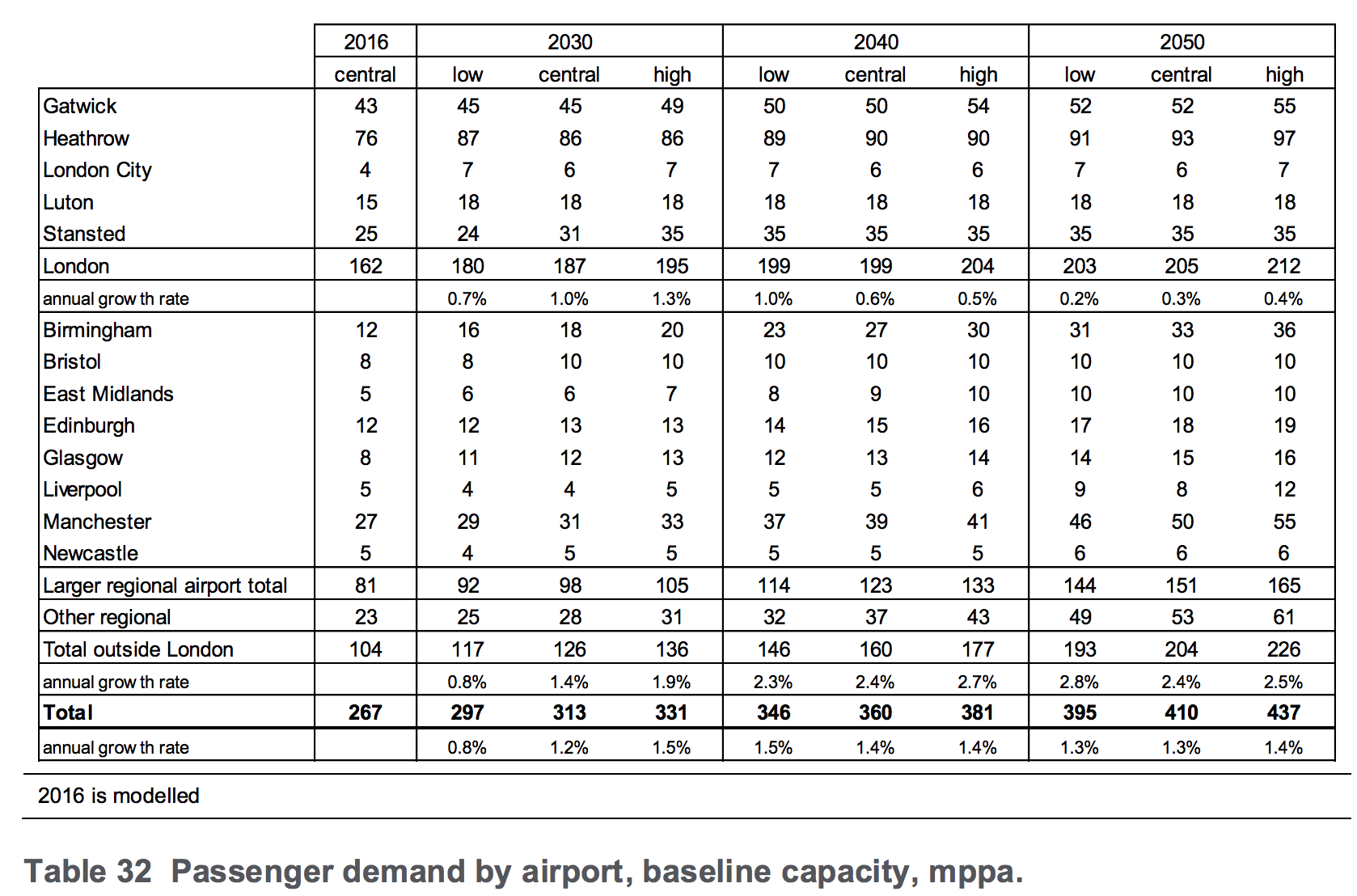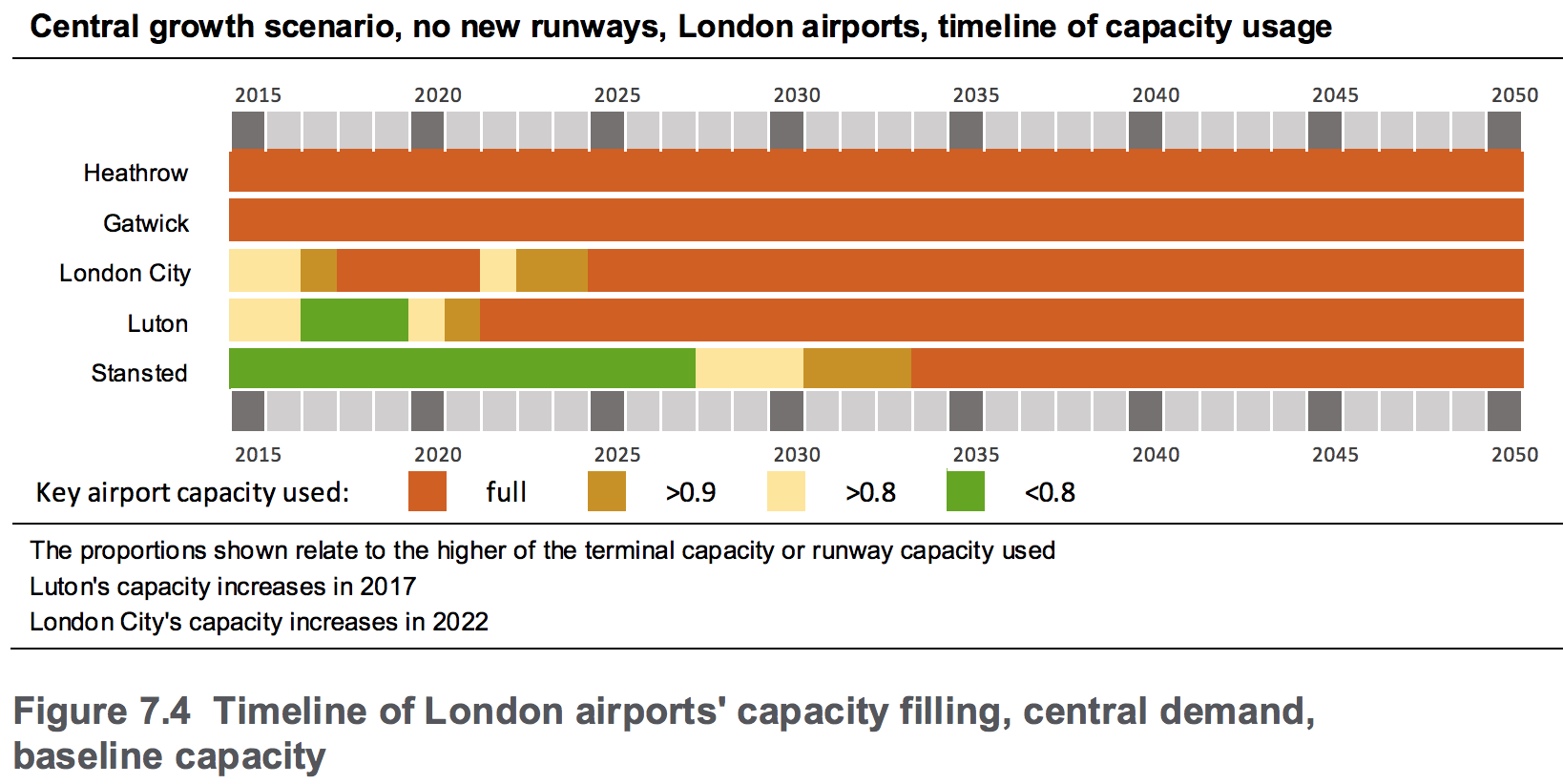Stop Stansted Expansion say Government’s Aviation Forecast figures undermine Stansted’s claims on need for expansion
Claims by Stansted’s management that the airport’s growth potential over the next decade is being severely limited by the present cap on numbers at 35 mppa are being called into question by local campaign, Stop Stansted Expansion (SSE) following the publication of new Government figures. These numbers are in the DfT’s forecasts, published as part of the 2nd consultation on the Airports NPS (ie. Heathrow runway). Stansted’s owners, MAG, predict that it will be completely full by 2023 – and it therefore needs an increase in permitted numbers to be able to accommodate 43 million passengers in 2028. But SSE show that in the new DfT UK Aviation Forecasts, reveal this is wrong. The DfT central forecast for Stansted is that it should expect to handle just 31 million passengers annually by 2030, and 35 million by 2033. Not by 2023. Stansted airport has been talking up the need for further growth – in anticipation of its application for planning permission from Uttlesford District Council in early 2018. And if there was a 3rd Heathrow runway, the DfT projects a decline in the number of Stansted passengers – from 24mppa in 2016 to 22mppa in 2030, and just 32 mppa by 2040. SSE say: “MAG’s overstatement of potential demand to secure support for expansion is nothing more than an opportunistic ploy.” See full SSE analysis.
.
Tweet
NEW GOVERNMENT FIGURES UNDERMINE STANSTED AIRPORT CLAIMS ON NEED FOR EXPANSION
6.11.2017
Press release by Stop Stansted Expansion (SSE)
Claims by Stansted bosses that the airport’s growth potential over the next decade is being severely limited by the present cap on numbers at 35 million passengers per annum (mppa) are being called into question by Stop Stansted Expansion following the publication of new Government figures.
While the airport’s owners, Manchester Airports Group (MAG), predict that Stansted will be bursting at the seams by 2023 and needs an increase in permitted numbers to be able to accommodate 43 million passengers in 2028, the long-awaited UK Aviation Forecasts, published by the Government at the end of October, reveal this to be a gross misrepresentation of the reality.
The Government’s central forecast for Stansted is that it should expect to handle just 31 million passengers annually by 2030, and 35 million by 2033 [see Note 1 below], rather than the inflated figures touted by the airport this year as it talks up the need for further growth in anticipation of its application for planning permission from Uttlesford District Council in early 2018.
The lower expectations of demand at Stansted take full account of the fact that the Government expects Heathrow, Gatwick, Luton and London City Airports all to be 100% full by 2030 (Table 33), based on no additional runways and current planning caps remaining in place.
Furthermore, if, as planned, a third runway is built at Heathrow in the next 10 years, the Government projects that demand at Stansted would actually decline, from 24mppa in 2016 to 22mppa in 2030, and that even by 2040 the airport would still only be handling 32mppa, i.e. less than the present cap, which would not be reached until 2043.
According to the new forecasts, therefore, it is clear that needless damage would be inflicted on the local environment by the building of additional aircraft stands and new taxiways at Stansted in coming years when these won’t be needed for at least another quarter of a century and, potentially, never needed: a second Gatwick runway, for example, would reduce the demand for more capacity at Stansted still further, while concerns about climate change, pressure from oil prices, and security concerns could also weaken demand.
Commenting on the findings, SSE Chairman Peter Sanders said: “MAG’s overstatement of potential demand to secure support for expansion is nothing more than an opportunistic ploy. It is designed to take advantage of a lull during Government consultations on the future of aviation and to try to rush through permissions that might otherwise be restricted once the new aviation policy emerges towards the end of 2018.”
Continuing, he added: “MAG has presented its case as if failure to concede a further tranche of expansion would somehow compromise the rights of the travelling public as well as the UK economy, when the Government’s own figures show this to be far from the truth.”
The new Government forecasts also show that Ryanair’s dominance at Stansted has further increased in recent years with the Irish airline carrying 82% of all passengers in 2016 compared to 64% in 2011. [see Note 2 below] Over the past five years all the other Stansted airlines have declined by a total of 1.4m passengers, shrinking from 5.8m in 2011 to 4.4m in 2016.
ENDS
Note to Editors
Note 1: see Table 32 and Fig 7.4 in UK Aviation Forecasts, published on 24 October 2017 and available at https://www.gov.uk/government/publications/uk-aviation-forecasts-2017.
Table 32 (from page 101) is copied below: [The text above it in the document states:
Baseline airport forecasts
7.18 Table 32 shows the scenario forecasts under baseline capacity. As the airports become full, the forecast demand range narrows and the annual rates of growth reduce. By around 2040 this effect is evident even in the low growth scenario.
7.19 The range of the demand growth scenarios remains wider outside London. However airports which share some overlaps of catchment areas with the London airports (e.g. Birmingham and Bristol) experience ‘spill’ of passengers from London seeking alternatives to London airport and in time such airports also near or reach capacity. A full version of this table is in Table 63 in the data annexes.

And Figure 7.4 (Page ) is copied below:

Note 2: ibid, page 66. It states: “Ryanair continues to dominate at Stansted, carrying 68% of the passengers in 2011 and 82% in 2016. “
.
For further information and comment contact:
- Brian Ross, Deputy Chairman, SSE: M 07850 937143 or brian.ross@lineone.net
- Carol Barbone, Campaign Director, SSE: M 0777 552 3091 or cbarbone@mxc.co.uk
- Sarah Cousins, SSE Campaign Office Manager: T 01279 814961 or info@stopstanstedexpansion.com
.
Stop Stansted Expansion group claims Government forecasts cast doubt on case for raising passenger cap
6 November 2017
Campaigners opposed to an increase in the cap on passengers numbers at Stansted claim that new Government forecasts for growth in air travel undermine the case for expansion put forward by the airport’s owner.
The Stop Stansted Expansion group points to figures in the Department for Transport’s latest UK Aviation Forecasts document which include a “central forecast” of 31m for annual passengers numbers at Stansted in 2030 – within the current cap of 35m.
SSE chairman Peter Sanders said: “MAG’s overstatement of potential demand to secure support for expansion is nothing more than an opportunistic ploy. It is designed to take advantage of a lull during Government consultations on the future of aviation and to try to rush through permissions that might otherwise be restricted once the new aviation policy emerges towards the end of 2018.”
He added: “MAG has presented its case as if failure to concede a further tranche of expansion would somehow compromise the rights of the travelling public as well as the UK economy, when the Government’s own figures show this to be far from the truth.”
However, the DfT report states that the purpose of the forecasts “is primarily in informing longer term strategic policy rather than in providing detailed forecasts at each individual airport in the short term”.
It says the overall national forecast is subject to a level uncertainty, which is all the greater when applied to individual airports.
The report also says that the forecasts aim to reflect current planning restrictions and “should not be considered a cap on the development of individual airports”.
A spokesman for Stansted Airport said that its growth over the past five years had “significantly exceeded” previous projections from both the Government and the Airports Commission, effectively putting it 10 years ahead of where official forecasts said it would be.
“Unfortunately, the Government’s recently published forecasts suffer from the same fundamental flaws as their previous forecasts, in particular their failure to take account of commercial drivers that have delivered the exceptionally strong growth for Stansted Airport and its low cost carriers, such as highly competitive air fares and long term commercial agreements with airlines,” he added.
“For that reason we welcome the DfT’s acceptance that the purpose of its recently published forecasts is not to provide detailed projections for each individual airport, and the recognition that other forecasts may be more appropriate in informing local planning decisions.
“Looking to the future, our independently prepared traffic forecasts show continued strong growth at Stansted, with the airport serving 35m passengers in 2023. These forecasts provide the airport with the business case for the substantial investment in new passenger facilities that we will be making over the coming years.”
.
.
.
.
.
